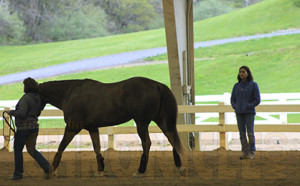5 Quick Tips For Perfecting Horse Show Patterns
 Information provided courtesy of Michigan State University Extension
Information provided courtesy of Michigan State University Extension
By: Taylor Fabus
With horse show season upon us, let’s focus on having our most successful year yet! Success means reaching goals, improving your personal performance, adding new skills, developing consistency and don’t forget enjoying the ride. Isn’t that why we do this “horse show thing?” Here we’ll focus on my top five tips to help improve your performance in the very popular pattern classes, such as Showmanship, Equitation and Horsemanship.
1. Study the pattern
First things first, you better know your pattern! It’s becoming more common for show management to share the pattern with exhibitors days or weeks before the show. Even if the pattern is only available the morning of the show, committing your patterns to memory is your first and most important step towards success.
Be sure to not only look at the diagram/drawing of the pattern, but also read the descriptive words provided. If you feel there is any conflicts or areas of confusion, let the show management know. They’ll clear up any confusion with the judge. The judge may even ask at the beginning of your class if you have any questions – use this opportunity if you have any lingering confusion.
2. Map out your path
Many of us are visual learners. I’ve found that the absolute best way to first practice your pattern is on your own feet, without your horse. I will set up a smaller version of the pattern, complete with cones, and “perform” it myself. You don’t need to ride your horse the first time you are learning the pattern. Allow your horse the rest and save him the confusion. While you “trot” out your pattern, you can begin to plan your path of travel, including which side of the cones you’re supposed to be on, distance from the cones, as well as where transitions and maneuvers are required.
Once you’ve successfully mapped out your course of action on your own, you can now add the equine element. The first few times I practice the pattern, I will simply walk or trot my horse through the required path of travel, removing the required transitions and maneuvers. This will help you plan your path in the arena without over practicing, which we’ll discuss later.
3. Plan your transitions
One of the keys to any successful show ring performance is found right in the transitions. Transitions show the horse’s athleticism as well as the communication between horse and rider. A well-practiced team will have prompt, collected transitions with subtle cues. In a pattern, a rider should plan when to ask for each transition, which will differ for each horse. Knowing how long it takes for your horse to pick up a canter will help you transition right where it’s called for in the pattern. In addition, this will set the pair up for success for whatever the next element is in the pattern.
Each skilled rider will know both their personal as well as their horse’s strong suits. As a showman, it is your role to highlight your areas of strength while of course minimizing your areas of weakness. For example, does your horse have a nice trot, but struggles with pivoting? Or is he a weak loper, but has a great stop? Plan your pattern so that you provide extra support for your horse during a difficult challenge while being sure you allow the judge to see your strengths in their full glory.
5. Don’t over practice
I’m sure you’ve heard practice makes perfect, but just be sure you don’t over practice your pattern, especially while you’re at the show. Even a new show horse can easily start to anticipate parts of the pattern once they’ve performed it few times. Use the tricks described in tip two above to be sure you get enough practice opportunities, without over doing it. While at home and at the show, I will practice riding around cones without asking my horse to perform any maneuvers or transitions at the cones. Horses often associate cones with a pattern maneuver, so riding past them will help your horse dissociate the two and prevent anticipation.
One other way to be sure you get enough practice without getting burnt out is to practice the pieces of the pattern separately. Before performing the entire pattern, be sure you’ve tuned your horse up on each element and transition separately. This is a very common practice technique of a successful showman. Once each element is tuned, you can then perform the pattern as described.
I hope you’ll find these five tips useful and that they help you have a successful show season ahead!
This article was published by Michigan State University Extension. For more information, visit http://www.msue.msu.edu. To have a digest of information delivered straight to your email inbox, visit http://bit.ly/MSUENews. To contact an expert in your area, visit http://expert.msue.msu.edu, or call 888-MSUE4MI (888-678-3464).











